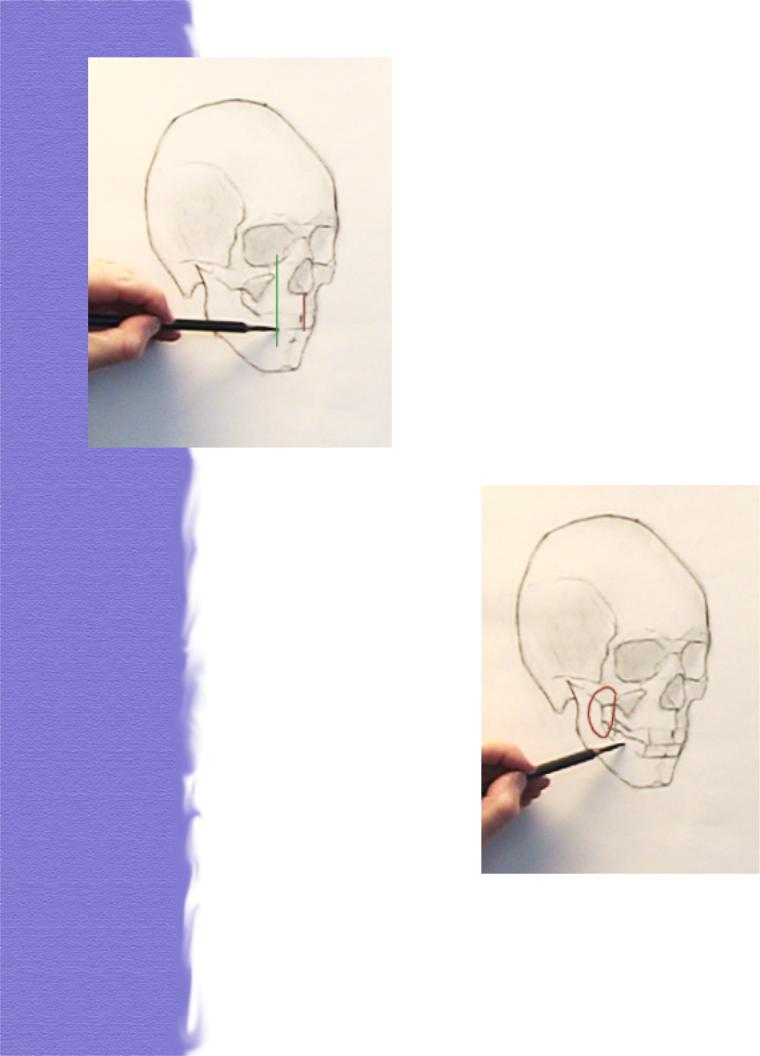
BRITTON Michael R - Drawing Skulls Part 3 - Teeth
.pdf
Drawing
Skulls Part 3
April 2005
TEETH: Michael R Britton
Most portraits are drawn with the mouth closed, yet rendering the face with a slightly opened mouth allows for a greater range of expression – from a relaxed intimacy to a raging howl. Whatever the expression, the teeth should not be the primary focus for the viewer.
This requires two considerations: first, the teeth must be drawn correctly and proportioned; this requires plumbing and aligning each tooth within the facial arena. Poorly drawn teeth will draw unnecessary attention to them. Second, teeth will invariably fall into shadow that is both cast from the lips and the fact that the teeth are recessed into the mouth. In painting, teeth are never white. At their brightest they are a mother-of-pearl gray. Subtlety and understatement are the keys to rendering teeth.
1-800-427-2468
© All rights reserved.

In most people the upper teeth close over the lower teeth: this is the ‘bite’. With very few exceptions the only teeth visible in an open mouth will
be the incisors and canine teeth. The premolars will usually just peek out from behind the cheeks. The top of the molars may subtly be seen in the lower denture.
Natural teeth are hardly ever perfectly straight blocks. Each tooth will have its own characteristics. The incisors are broad and chiseled – designed to cut. Most people will have a slightly chipped medial incisor.
Look for a slightly askew lateral incisor, again, it is a common element. The canine (eye tooth) is generally the longest and is pointed; be careful not to exaggerate it. Otherwise your portrait will have a vampire-like effect.
When drawing from your skull (which, if you are serious about developing your drawing skills you really should own one) the alveolar process must first be ascertained. The alveolar process is the horseshoe shaped ‘denture’ that contains the sockets for the teeth. The small measure (the red line) from the anterior nasal spine to the alveolar process is too small to be measured. It must felt. As I’ve said many times, this tactile sensibility (the ‘felt’) is a learned skill requiring both practice and knowledge.

Several elements must know be established and fixed into place. First is the lower border of the alveolar process (the lower teeth’s gum line). Again, feel you way down from the upper gum line and double check by feeling your way up from the chin’s mental process.
Second, mark the interstice where the upper and lower medial incisive teeth meet. (The upper teeth are usually larger than the lower.)
Third, the vertical division of the two front medial incisors are placed by plumbing down (the red line) from the anterior nasal spine. Note that the vertical division of these two front teeth are slightly to the left of the anterior nasal spine. This is something to always look for!
Fourth, the canine tooth is placed by plumbing (green line) and relating to either the zygomatic process (it’s a bit to the right of it here) or the eye socket. You are looking for a viable landmark that you believe is accurate.
As the teeth progress back to the molars the interstice is always an upwards angle until it meets the coronoid process (circled in red). You can almost feel the coronoid process with you tongue – it is just behind the wisdom teeth.
I think it best to first define the teeth by carefully drawing the interstice. Avoid the tooth-by- tooth route.

Now is the time to sketch in the individual teeth take note of each tooth’s individual character. Avoid what I did – don’t exaggerate the canine. But if you do it is easily fixed.
Now that I’ve corrected the errant canine I softened the lines of the individual teeth so that they are subtle and read pretty much as teeth and not as a bunch of tooths (grammar aside). I refined and slightly darkened the interstice which emphasizes the bite.
Throughout the drawing of this skull a small error managed to escape my detection. The ramus (circled in red) is off. Totally. But it is easily fixed. The hard part is detecting your errors. Usually it is a gut feeling that something is amiss. The quick way to check your drawing is by looking at its reverse image in a mirror. It’s a brutal method, but one that always illuminates the errors of your drawing.
